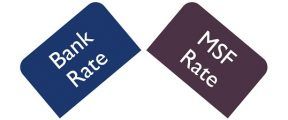 Bank Rate and Repo Rate are the tools of RBI, which helps to control the money supply in the economy. They are the lending rates, at which the apex bank of the country lends funds to the commercial bank. The bank rate refers to the standard rate, at which the Central Bank of India readily purchases or rediscounts bills of exchange and other commercial paper, that are eligible for purchase under the act.
Bank Rate and Repo Rate are the tools of RBI, which helps to control the money supply in the economy. They are the lending rates, at which the apex bank of the country lends funds to the commercial bank. The bank rate refers to the standard rate, at which the Central Bank of India readily purchases or rediscounts bills of exchange and other commercial paper, that are eligible for purchase under the act.
Conversely, when the economic system of the country encounters liquidity shortages and the interest rates are rising, the RBI purchases government securities from banks and pays for the same, to better the liquidity position of the country and expand credit. The process is known as repurchase action and the rate at which the securities are bought is called repo rate.
Due to some similarities between these two rates, it is often difficult for people to understand the difference between bank rate and repo rate. If you take a glance on the present rates, then you must have observed that bank rate is higher than the repo rate.
Content: Bank Rate Vs Repo Rate
Comparison Chart
| Basis for Comparison | Bank Rate | Repo Rate |
|---|---|---|
| Meaning | Bank Rate is the rate of interest, which is charged by the Central bank on the loans, it advanced to commercial banks and other financial institutions. | The rate at which the Central bank grants short term loans to commercial banks, against collateral are known as Repo Rate. |
| Repurchase Agreement | No | Yes |
| Deals with | Loans | Securities |
| Time Frame | Long Term | Short Term |
| Collateral | Not involved | Involved |
| Which is higher? | Higher | Relatively lower |
Definition of Bank Rate
By the term bank rate, we mean an interest rate, charged by the country’s central bank on the loans and advances extended to the domestic banks like a commercial bank, cooperative bank, development banks and other financial intermediaries. These loans cater long term financial requirements of banks and financial intermediaries. It is regulated by Central bank’s long-term monetary policies.
Bank Rate is one of the essential tools of the Central Bank, which regulates the economic activity level, i.e. to control liquidity, the apex bank will increase bank rate and vice versa. As a result of which the borrowing cost of banks goes up, and the credit supply in the economy goes down. An upward revision in the bank rate signals that the banks should also raise their lending rate and the deposit rates.
Definition of Repo Rate
Repo rate is the rate at which banks borrow money from the Central bank, on the event of a deficiency of funds. The term ‘repo’, is an acronym for repurchase option, that acts as a source of short-term borrowing, in which the banks sell securities to the central bank, in return for credit. The securities are government approved securities, that act as collateral.
Central bank uses this tool to control money supply in the country’s monetary system, i.e. the decrease in the repo rate indicates that the bank’s cost of borrowing is reduced while if the repo rate goes up, it represents that bank’s borrowing rate is expensive, that ultimately results in the fall in money supply in the economy. In this way, it also helps the government authorities to curb inflation.
Key Differences Between Bank Rate and Repo Rate
The difference between bank rate and repo rate are explained, in the given below points:
- Bank Rate is the discount rate at which the Central Bank extends a loan to the commercial bank and financial institutions. Repo Rate is described as a rate at which Central Bank extends a short-term loan to the commercial bank.
- In a bank rate, there is nothing like repurchase agreement; only the money is lent to banks and financial intermediaries at a fixed rate. Conversely, in Repo Rate, the sale of securities to the central bank, on a repurchase agreement, i.e. to buy back the securities at a predetermined rate and date in the future.
- The bank rate is charged on the loan extended to the commercial bank by the apex bank. As opposed to Repo Rate, is the rate of interest, charged on the repurchase of securities.
- In general, bank rate caters long term fund requirement of the commercial banks whereas the repo rate focuses on providing short-term finance to banks.
- In the case of bank rate, the loan is provided to banks without collateral. On the other than, in repo rate loan is granted to the banks, after pledging bonds as security.
- The bank rate is normally higher than the repo rate.
Conclusion
The central bank uses repo rate and bank rate as a tool to inject or curb liquidity in the banking and monetary system of the economy. The two terms differ in a sense that bank rate is just a lending rate at which central bank lends money to other banks whereas, in the case of repo rate or repurchase transaction, the government buys back securities from domestic banks.






Prawesh Kumar rajak says
Good definition
ARBAZ says
Really helpful for me, nicely explained